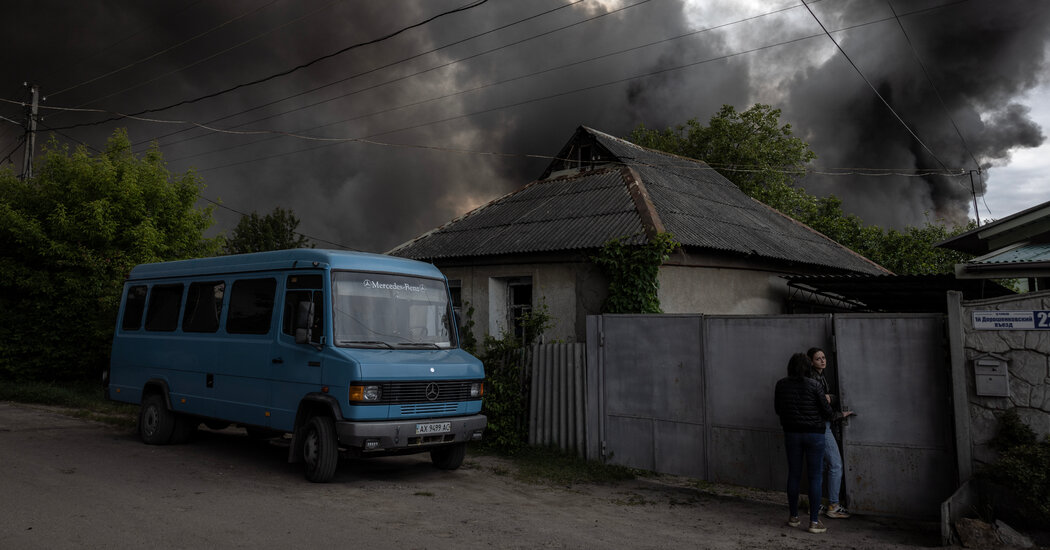
Russian forces continued to advance heavily into northeastern Ukraine on Saturday, closing in on a village about 10 miles from the Kharkiv Outer Ring and raising fears that the city, Ukraine's second largest, could soon be in the range of Russian artillery.
The Ukrainian army said Saturday that Russian troops attempted to break through its defenses near the village of Lyptsi, which lies directly north of Kharkiv. The attacks were repelled, but battlefield maps compiled by independent groups that analyzed publicly available videos of the fighting showed that Russian troops had almost reached the outskirts of the village.
Ukraine's Khartia Brigade, which is defending Lyptsi, posted a video on Telegram on Friday afternoon in which Russian soldiers could be seen advancing on foot towards the village and attacking in small groups between rows of trees. The brigade said it targeted the Russians with rockets, forcing them to retreat.
Russian troops opened a new front in northeastern Ukraine a week ago, crossing the border and quickly capturing about 10 settlements in what Ukrainian officials and military analysts described as an attempt to overstretch already outnumbered Ukrainian forces .
The Khartia Brigade, for example, was redeployed from another hot spot on the front, around Ocheretyne, a village in the south-east. Russian forces captured Ocheretyne last month, blowing a hole in Ukrainian defenses.
But experts say another, perhaps more immediate, goal for Russia could be to advance deep enough into Ukrainian territory to push Kiev's forces away from the border, creating a buffer zone that would prevent the Ukrainians from targeting countries and Russian cities with artillery. President Vladimir V. Putin said Friday that this is the goal of the current offensive.
A buffer zone could also allow the Russians to get close enough to Kharkiv to hit it with artillery shells, escalating Moscow's campaign to inflict hardship on the city's residents by hitting residential neighborhoods with airstrikes and targeting its power plants to cut off 'electricity.
“A 10-15 kilometer buffer zone would definitely create a problem for Kharkiv,” said Mykola Bielieskov, a military analyst at the government-run National Institute for Strategic Studies in Ukraine.
Further Russian advances would return Kharkiv, now home to about 1.2 million people, to the situation it faced in the first months of the war. In 2022, Russian troops reached the city's outer ring, forcing hundreds of thousands of people to flee.
Kharkiv Mayor Ihor Terekhov described Russia's advance into the city as designed to sow chaos and panic. But this week he reiterated that there were no plans to evacuate the population. Instead, the city served as a temporary home for thousands of Ukrainian civilians who fled fighting in the region, from villages such as Lyptsi or Vovchansk, further east.
Kharkiv, however, is not entirely safe. In recent months, Russia has increasingly targeted the city with powerful guided missiles known as glide bombs, which can carry hundreds of tons of explosives, and S-300 anti-aircraft missiles, which Moscow now uses to attack targets on the ground.
“The time it took for the S-300 missiles to reach Kharkiv – it's just a few minutes,” Ilya Yevlash, a spokesman for the Ukrainian Air Force, said in an interview this month. “There is no time to react to these threats.”
Only US-made Patriot air defense systems can intercept short-range launched S-300 missiles, Yevlash said, and Ukraine doesn't have enough of them. “We can count them on one hand,” he said.
Ukrainian officials have urged their Western partners to send more. “We extremely need air defense to protect Kharkiv” and other cities in northeastern Ukraine, Andriy Yermak, head of President Volodymy Zelensky's office, said in an interview with the New York Times this week. “It's time.”
Putin said Friday that Russian forces had no intention of taking the city itself. Military experts also say that Russia does not have the forces to conduct such an operation.
Getting closer to Kharkiv, however, will not be an easy task.
So far Russian forces have pushed through largely depopulated and poorly fortified areas. Entering Lyptsi, which before the war had a population of 4,000 and is dotted with houses and buildings, will force Russian troops to engage in more difficult street fighting.
Emil Kastehelmi, an analyst for the Finnish group Black Bird, who analyzed satellite images and footage of the battlefield, noted on the social platform X that “a long chain of villages” separates Lyptsi from Kharkiv. Advancing through them one by one, he said, “would force the Russians to fight through more than 17 kilometers of built-up areas.”
Matina Stevis-Gridneff contributed a report from Brussels.
